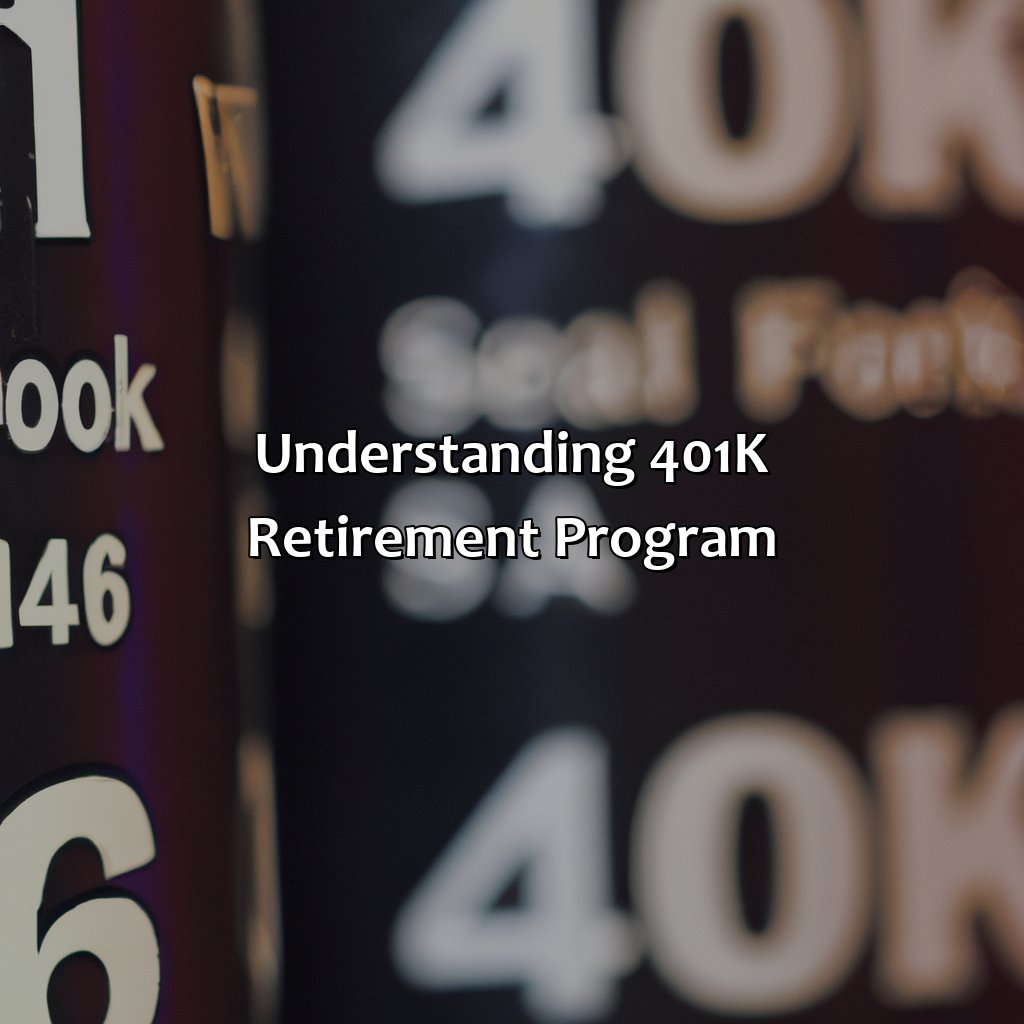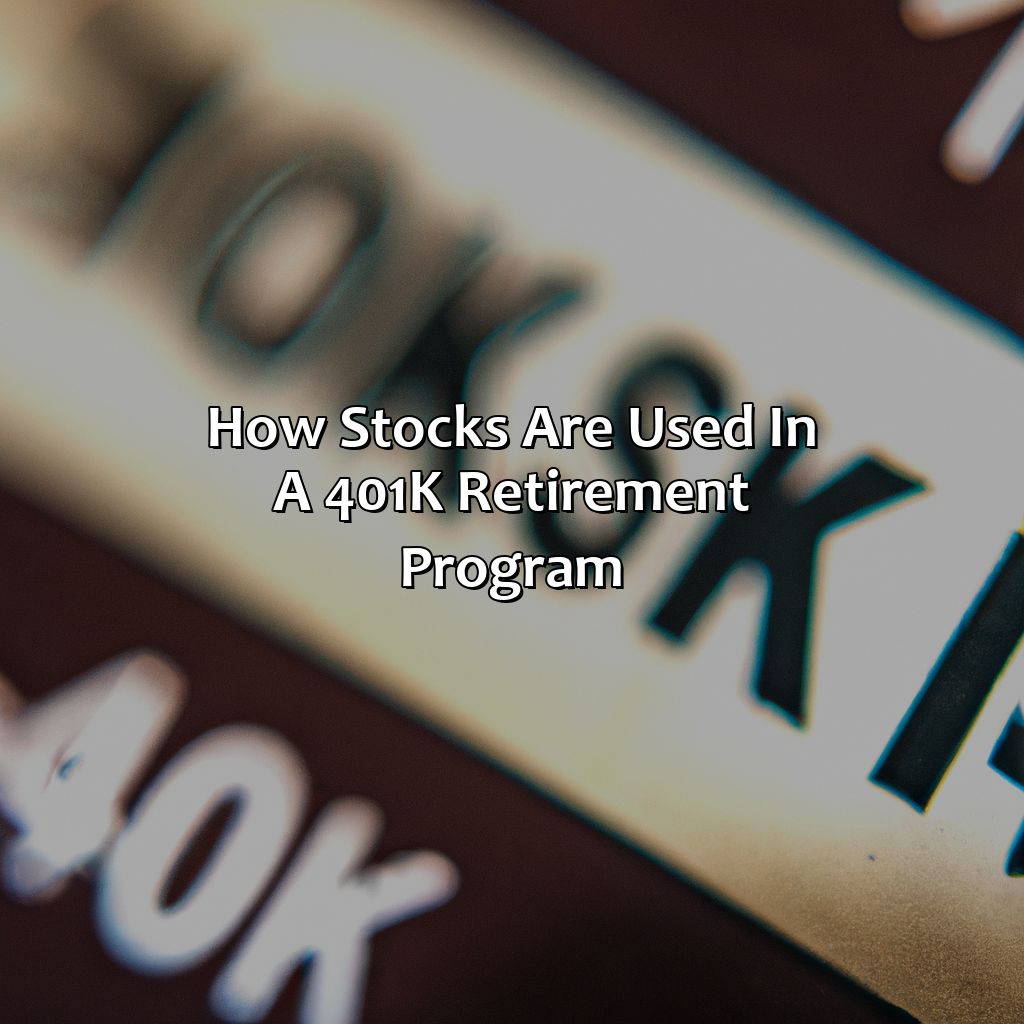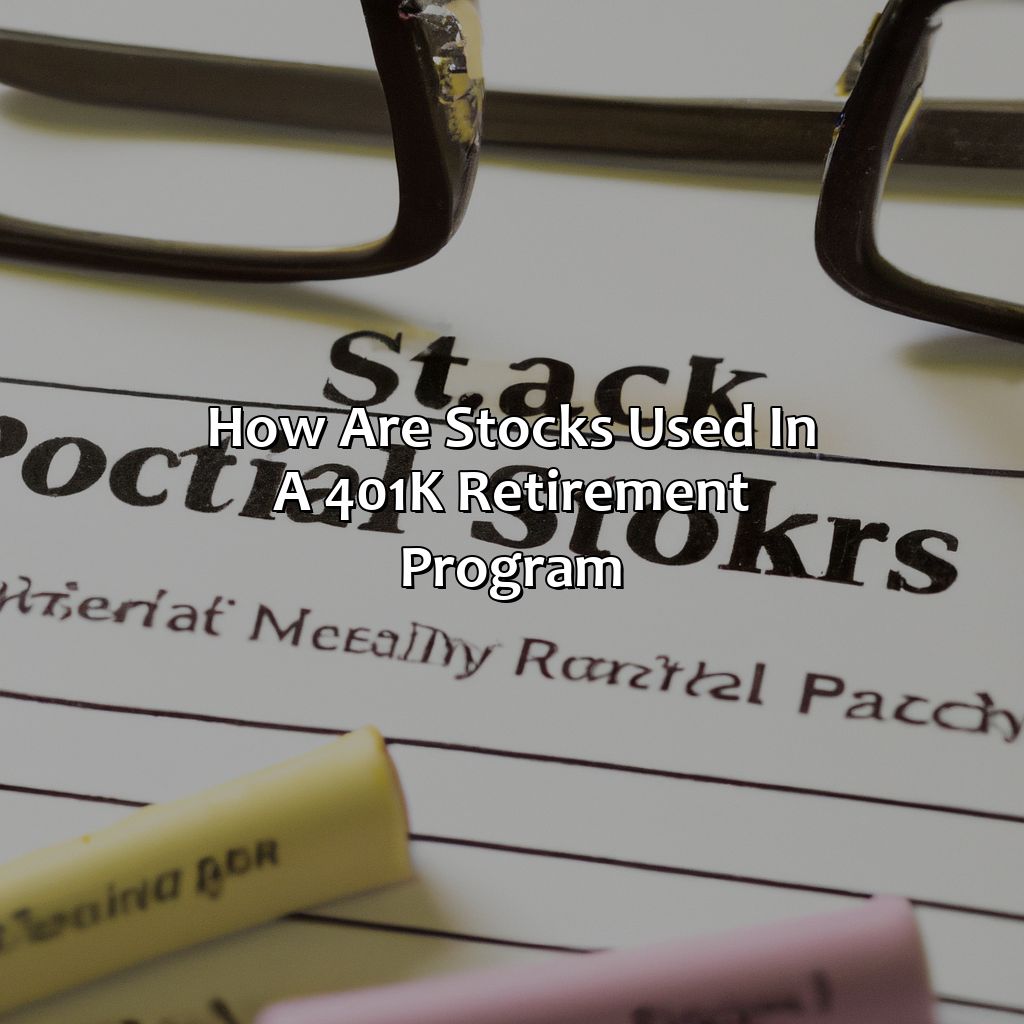How Are Stocks Used In A 401K Retirement Program?
Key Takeaway:
- Stocks play an important role in a 401k retirement program: They offer the potential for higher returns compared to other investment options, such as bonds or cash, and can help investors to build wealth for their golden years.
- There are different types of stocks to consider when investing in a 401k plan: These include large-cap stocks, small-cap stocks, and international stocks. Diversification across different stock types can help to reduce risk and maximize returns.
- Investing in stocks for retirement can provide several benefits: Over the long term, stocks have historically outperformed other asset classes, helping to build wealth and combat inflation. Additionally, dividend-paying stocks can provide a source of income for retirees.
Are you looking for ways to secure your financial future? Stocks play an important role in a 401k retirement program, providing you with the tools to achieve your retirement goals. Discover how stocks can help you reach your financial dreams and secure a worry-free retirement.
Understanding 401k Retirement Program
In the world of retirement planning, 401k programs are a popular option. These programs allow employees to invest a portion of their salary into a retirement account, often with an employer match. One of the investment options within a 401k program is stocks. Stocks allow the account to potentially grow over time while also providing some level of risk. It is important to choose stocks wisely and diversify investments to help mitigate risk. When the time comes for retirement, the account holder can choose to liquidate stocks for cash to live off of. Participating in a 401k program and investing in stocks can help individuals plan for a financially stable retirement. A Pro Tip for those investing in stocks within a 401k program is to regularly review and adjust investments based on market trends and personal financial goals.

Image credits: retiregenz.com by David Arnold
How Stocks are Used in a 401k Retirement Program
To grasp how stocks can help in your 401k retirement program, investigate the gravity of stocks in a 401k plan. Know the types of stocks to invest in a 401k plan. Also, comprehend the advantages of investing in stocks for retirement. These subsections offer solutions that can assist in your retirement planning.

Image credits: retiregenz.com by David Arnold
Importance of Stocks in a 401k Plan
Stocks- A Key Driver in a 401k Retirement Program
A well-diversified portfolio is critical when it comes to planning for retirement, particularly through effective utilization of stocks. A 401k plan’s primary objective is to maximize returns using diversified investment options, including bonds and mutual funds, but stocks can play a pivotal role in achieving financial security.
When investors allocate their assets within a 401k retirement program, they often consider investing a portion of their money in stocks. Stocks’ higher potential for growth compared to other products such as bonds contributes towards this consideration. However, selecting the right stocks to invest in can be challenging due to volatile market conditions and associated risks.
There are several types of stocks available in the market that investors can choose from based on their risk appetite and expectations. Moreover, selecting the correct allocation based on the age and time horizon of investors becomes an important task.
Stocks may go up and down, but with the right types, your 401k retirement plan will never frown.
Types of Stocks to Invest in a 401k Plan
When it comes to choosing the right kind of stocks for a 401k plan, there are plenty of options available. In order to maximize your retirement savings, it’s important to understand the types of stocks that may be beneficial for your portfolio. Here are some variants of stocks that can be considered for your 401k plan:
- Blue Chip Stocks: These are established and well-known companies with a proven track record.
- Small-Cap Stocks: These companies have a smaller market capitalization and may offer greater growth potential.
- Growth Stocks: These rapidly growing companies with high earnings potential often reinvest their profits into the business rather than paying dividends.
- Value Stocks: These stocks are undervalued by the market and may offer an opportunity for long-term gains.
- International Stocks: Investing in companies from around the world can help diversify your portfolio and mitigate risk.
- Sector-Specific Stocks: Investing in specific sectors such as technology, healthcare or energy can offer an opportunity for focused gains but also entail higher risks than investing in diversified portfolios
It’s important to note that diversifying your 401k plan across multiple stocks is key to spreading out risk while maximizing potential returns over time. It requires proper research to find good stocks that align with your financial goals while keeping in mind fluctuations in stock prices.
Stocks within a 401k retirement program were deregulated during President Ronald Reagan’s presidency in the early ’80s, paving the way for investment firms and banks to start organizing programs and charging employees fees. Almost every retirement plan today offers mutual funds containing many individual company holdings instead of direct investments into single company holdings.
Retiring with a bank account full of stocks may not guarantee happiness, but at least you’ll have the funds to buy a lifetime supply of ice cream and Netflix subscriptions.
Benefits of Investing in Stocks for Retirement
Stocks play a crucial role in securing a retired life, and investing in them can aid in generating a passive source of income that can be used post-retirement. Here are some benefits of incorporating stocks into your retirement plan:
- Stocks display higher returns compared to other assets and deliver better growth potential for long-term investment.
- Investing in large-cap stocks provides stability and assures profitability for the portfolio, curbing risks associated with stock investment.
- Stocks offer diversification to the portfolio by gaining exposure to various industries while expanding investments.
- Dividend-paying stocks provide consistent income after retirement, providing financial security during unpredictable times.
- Liquidation enables quick conversion of stocks to cash, facilitating urgent requirements during emergencies.
If you choose the right mix of funds comprising stocks coupled with bonds, you can expect long term growth and financial security after retirement. Keep in mind that market trends fluctuate frequently, and performing comprehensive research before making any investments is essential.
As they say, “Do not put all your eggs in one basket,” it is sensible to devise an investment strategy that mixes both viable short- and long-term investing options.
Did you know hedge funds contribute massively towards the global economy? According to 2021 reports from Statista, hedge fund’s total AUM stands at $3.6 trillion USD.
You never know what’s riskier – investing in stocks or trusting your future to a Magic 8 Ball.
Factors to Consider Before Investing in Stocks in a 401k Plan
Evaluate three crucial factors to invest with confidence in a 401k retirement program: your risk tolerance, diversification options and investment goals.
Gain key advice to make wiser choices in the complicated world of 401k investments.
Weigh all these sub-sections for a successful outcome!

Image credits: retiregenz.com by Joel Arnold
Risk Tolerance
Investment Readiness in 401k Plans can be influenced by your Capacity for Market Risk. Before investing, it’s important to assess your tolerance level for market volatility. It is vital in ensuring you make decisions that align with your risk capacity and goals.
By understanding your risk appetite, you’ll be able to choose the most fitting asset allocation mix that helps achieve an optimal balance between potential returns and risks of your portfolio. Constantly rebalancing this mix as needed will ensure long-term stability of retirement savings.
Diversification via a wide range of investment choices available in 401k plans should also be taken into account. These options offer various levels of industry sectors, stock sizes or global locations for better portfolio spread.
The selection of stocks should always reflect your risk mentality carefully keeping other factors like management quality, financial strength or credit rating of the underlying corporation in check.
Successful investors are individuals who tailor investment techniques to their own individual circumstances. As experienced and successful investors like Buffett put it “Risk comes from not knowing what you’re doing.”
You could diversify your investment portfolio by throwing darts at a list of stocks, but using a sound strategy might yield better results in the long run.
Diversification
Effective Portfolio Variation
A well-diversified portfolio is essential for a 401k plan. By investing in different asset classes, the investor can reduce the risk associated with putting all of their assets into one field. Investment income can vary year by year. The diversified alternatives available to an investor guarantees a steady income stream for the long haul.
To achieve ideal diversification, investors should choose investments with different amounts of risks within each asset class and in various market conditions. An investor should consider investing in a combination of stocks, bonds, real estate for maximum output; first understanding their unique options and evaluating how they manage those funds based on their target retirement age.
By analyzing past performances of mutual funds chosen by professional managers can contribute knowledge and insights concerning current market trends and future potential outcomes.
Don’t fall out
Remember, a retirement plan without investment goals is like a burger without the patty – it may look okay, but it’s missing the meat.
Investment Goals
Setting Achievable Financial Targets
When considering investing in 401k plans, it’s crucial to set feasible investment objectives. Defining clear and realistic targets will enable you to identify the progress towards your financial goals accurately. Ensure that you acknowledge both short-term and long-term objectives before choosing an investment strategy.
Maximize Retirement Savings
To assist in meeting retirement savings, choose investment options that optimize growth potential while reducing risks. It is wise to have a diversified portfolio with various assets such as stocks, mutual funds, or bonds. A mix of these investments provides balance and minimizes volatility.
Assess Risk Tolerance
Understanding your risk tolerance involves identifying how much money you are willing to lose with market movements. Before selecting stocks to invest in, assess your willingness or ability to withstand fluctuations regularly. Experts suggest avoiding emotions when investing since speculation can lead to knee-jerk reactions that may cause losses.
Plan Your Asset Allocation
401k plans allow for a range of equity investments, including domestic and foreign stock markets. The allocation of your portfolio affects returns on investment by balancing risk factors among different asset classes such as bonds, mutual funds, and individual stocks. Reviewing the allocation of your assets on a regular basis can help optimize returns while minimizing risks.
Do not fall Behind on Savings
Investing early has many benefits, including providing more time for returns on investments to accumulate and thereby improving future prospects for retirement security. Therefore delay in saving towards retirement can have significant impacts on future living standards. Begin early into your working career so that compounding interest earns steadily over time while allowing adjustments along the way.
Missing out on securing a bright financial future could be disastrous; act now by creating achievable objectives, understanding risk tolerance, diversifying portfolio asset allocations & starting early in developing automated savings to secure retirement with assurance of having sufficient financial resources at one’s disposal later in life.
Five Facts About How Stocks Are Used in a 401k Retirement Program:
Stocks are a common investment option in 401k retirement programs. (Source: Investopedia)
Investing a portion of a 401k in stocks can potentially yield higher returns over the long term. (Source: Charles Schwab)
Stock market fluctuations can have a significant impact on the value of a 401k portfolio. (Source: Fidelity Investments)
Diversifying a 401k portfolio with a mix of stocks, bonds, and other assets can help to mitigate risk. (Source: Vanguard)
Many 401k retirement programs offer target-date funds that automatically adjust the allocation of stocks and bonds based on the employee’s expected retirement date. (Source: T. Rowe Price)
FAQs about How Are Stocks Used In A 401K Retirement Program?
How are stocks used in a 401k retirement program?
Stocks are one of the common investment options in a 401k retirement program. They allow an individual to invest in the ownership of companies and potentially earn higher returns over the long term.
What types of stocks can be included in a 401k?
A 401k retirement program can include a variety of stocks, including individual stocks, mutual funds that hold stocks, and exchange-traded funds (ETFs) that invest in stocks.
Can stocks be a risky investment in a 401k?
Yes, stocks can be a risky investment in a 401k retirement program, as their value can fluctuate significantly depending on the performance of the company and the broader market. However, over the long term, stocks have historically provided higher returns than other investment options.
How do I select stocks for my 401k?
Most 401k retirement programs offer a range of investment options, including pre-selected stock portfolios or funds that invest in a variety of stocks. It’s important to consider your age, risk tolerance, and investment goals when selecting stocks for your 401k.
What are the tax implications of investing in stocks through a 401k?
Investing in stocks through a 401k retirement program can offer tax benefits, as contributions are made on a pre-tax basis and you won’t owe taxes on any investment gains until you withdraw the funds. However, withdrawals made before age 59 1/2 may incur taxes and penalties.
How much should I invest in stocks through my 401k?
The amount you should invest in stocks through your 401k retirement program depends on your age, risk tolerance, and investment goals. It’s generally recommended to have a diversified portfolio that includes a mix of stocks, bonds, and other investment options.
 Checkout this IRS Loophole
Checkout this IRS Loophole 





